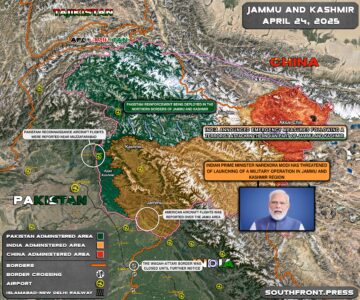The fragile peace between India and Pakistan has been shattered following a brutal terrorist attack in Indian-administered Kashmir, plunging the nuclear-armed rivals into their most severe crisis since 2019. On April 22, militants from The Resistance Front (TRF), a group New Delhi links to Pakistan-based Lashkar-e-Taiba, opened fire on tourists in Pahalgam, killing 26 people.
Survivors recounted how assailants selectively targeted non-Muslims, executing victims after verifying their religion. The attack has triggered a rapid and unprecedented escalation, with India imposing sweeping punitive measures against Pakistan, including the suspension of the 1960 Indus Waters Treaty, a cornerstone of regional stability that allocates river resources between the two countries.
Narendra Modi’s government has adopted a hardline stance, signaling a strategic shift from past responses. Beyond expelling Pakistani diplomats and closing border crossings, New Delhi’s decision to halt water-sharing agreements strikes at Pakistan’s existential vulnerability: 80% of its agriculture depends on the Indus River system. This move, never before taken even during full-scale wars, risks triggering a humanitarian crisis in Pakistan’s arid regions. Meanwhile, India has canceled all Pakistani visas and ordered citizens to leave within 48 hours, a measure reminiscent of pre-war expulsions. Security officials hint at imminent cross-border strikes targeting militant camps in Pakistan-administered Kashmir, mirroring the 2019 Balakot airstrike.
Islamabad, while denying involvement in the attack, has retaliated closing airspace to Indian flights and suspending bilateral trade. Its rhetoric has grown ominous. A senior security official warned that revoking the Indus Treaty would be “an act of war,” while Pakistan’s National Security Committee convened an emergency meeting.
Military movements along the Line of Control and the deployment of reconnaissance aircraft suggest preparations for a potential Indian incursion. Analysts note Pakistan’s precarious position: its economically crippled government cannot afford a war, yet its military, historically the arbiter of foreign policy, faces pressure to respond forcefully to any Indian strikes.
The Nuclear Shadow and Great Power Calculations
With both nations possessing 250–500 nuclear warheads, the risk of miscalculation looms large. Pakistan’s doctrine of “full-spectrum deterrence” permits early nuclear use if conventional defenses collapse, while India’s “Cold Start” doctrine envisions rapid limited strikes to punish Pakistan without triggering a nuclear response. This delicate balance is further complicated by external actors: China, Pakistan’s key ally, has urged restraint but maintains strategic infrastructure projects in Kashmir, while the U.S. has tilted toward India, supplying advanced weapons like the F-21 fighter. Russia, meanwhile, seeks to mediate via the Shanghai Cooperation Organization, though its leverage is limited by arms sales to both sides.
Historical Echoes and Escalatory Risks
The crisis mirrors the 2019 Pulwama attack, which nearly sparked a war after India bombed Balakot. This time, however, the stakes are higher. India’s revocation of Kashmir’s autonomy in 2019 and subsequent crackdowns have radicalized local youth, fueling groups like TRF. Pakistan’s economic freefall and political instability make it less capable of restraining jihadist proxies. Experts warn that Modi’s domestic pressures, facing elections amid rising Hindu nationalism, could incentivize a disproportionate response.
Short-term de-escalation hinges on backchannel diplomacy, likely facilitated by third parties like the UAE or Oman. However, with India’s military reportedly massing near the Line of Contact and Pakistan’s air defenses on alert, the window for dialogue is narrowing. The coming days may see limited Indian strikes on militant bases, met by Pakistani artillery barrages, a cycle that could spiral out of control. The world’s most dangerous flashpoint is now a tinderbox waiting for a spark.









